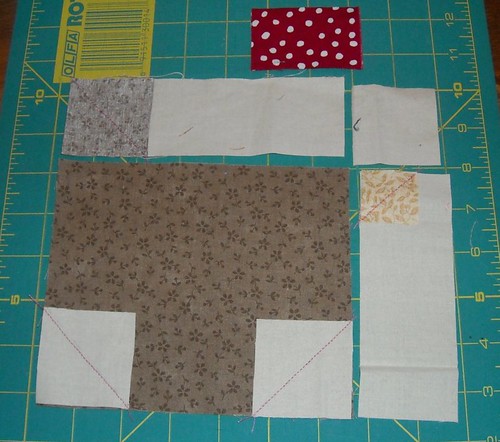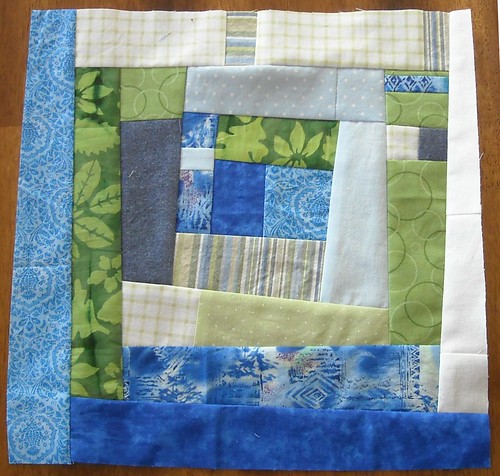Machine quilting takes practice, but it's much faster than hand quilting and I love the look when it's finished. It's probably a good idea to make some 12 inch "quilt sandwich" squares of batting in between two layers of muslin and practice quilting those first. And also, know that it takes time and practice to develop this skill. Your quilting will improve with each quilt.
So... here we go!

There are several things you need to do to get your machine ready to machine quilt. You need a darning or free motion quilting foot. The special thing about this foot is that it
goes up and down with the needle while you are sewing. This makes it so you can move the quilt any way you want while you are quilting it.
Lower the feed dogs on your machine. I have read that if your feed dogs don't go down, you can tape an index card over them. I haven't tried that though. You don't want the feed dogs telling your fabric which way to go; you are going to be moving it with your hands.

If your machine has adjustable presser foot pressure, you probably need to adjust it so there is space under the presser foot when the lever for the foot is in the down position. You have to have the presser foot in the down position in order to have top thread tension; if you don't have top thread tension, you can't sew. This picture shows the little black dial to adjust the presser foot pressure on my old Viking machine.
Your machine may not have adjustable presser foot pressure; one of my sewing machines does not. I can still machine quilt with that machine because it has a quilting foot that goes up and down with the needle while I sew.
I'm sure there are other types of machines and setups for machine quilting, but I only have experience quilting with two types of sewing machines. Whatever you need to do to get ready to machine quilt, you need to have your presser foot go up and down with the needle when you sew.
And finally, don't forget to change to a new needle. They actually make machine quilting needles, which I have used, but I haven't noticed a difference between those and regular universal needles.

Get some machine quilting gloves or other gripping device. I got my gloves at a local quilt shop, and I like them. They have plasticky gripper dots on the fingers and palms and make it much easier to move the fabric around while I'm quilting. There are also other options for helping you get some grip on your palms and fingers and you can find them if you do a search for quilting notions or quilting gloves.

If your sewing machine has a table extension thing, use it. If your machine fits into a cabinet and you have a flat surface, that's even better.

Next you need to get your quilt ready to fit on the machine. This is a baby quilt that's about 36"x42". It's not that difficult to quilt, but bigger quilts require more wrangling and patience. For a baby quilt, I quilt half of it, lengthwise, at a time. First, roll one side in to the halfway point; this side will be to the left of my needle.

Then, roll the other side in a little bit, leaving 5-6" or so unrolled in the middle.
(With larger quilts, you will probably do 3 or 4 or more sections of quilting, adjusting how the quilt is rolled up each time.)

Next, take the quilt and accordion-fold it from the bottom. The folded part will be placed in your lap and you will start quilting at the top.

First, position the quilt, lower the presser foot, and then using the hand wheel (is that what it's called?) take one stitch and pull the bobbin thread to the top.

Make sure the needle is right above where the bobbin thread comes up, and sew 3-4 stitches in one place. This anchors the threads and then, ta da! You are ready to quilt. You will need to pull the bobbin thread up like this each time you start stitching.

My son, who is 7, took this picture. It is supposed to show my hand position when I'm starting quilting. It's not the best angle to actually show that, sorry.

I quilted over to the right side of the quilt, unrolling it a bit as I went.

When I went back to the left, I had to roll up the right side of the quilt again.

I ran out of bobbin thread so I decided to take a picture and show you how it looks so far. You might want to make sure you have a full bobbin, or two or three, before you start. When you stop quilting (on purpose that is, not when you run out of bobbin in the middle) you need to sew 3-4 stitches very close together to keep your quilting line from coming undone. When my bobbin runs out, I just start sewing about 1/2" before the spot where my bobbin ran out, and sew right on top of those last few stitches.

Here's the back.

In this picture, I'm getting close to the bottom of the quilt. I find it helps control the motion of the quilt if I fold the top of the quilt under as I get closer to the bottom.

This is the quilt with the first half of the quilting finished.

This is the back of the quilt, showing a little closer up view of the unquilted and quilted areas. After you finish quilting the first side of the quilt, you will need to lay it out again, and roll up the already quilted side so you can quilt the other side. Try to make the second section of quilting blend in with the first section.

This shows the quilting all finished.

Here is a closer view of the quilting from the back. And, a little discussion about the meandering style of quilting that I used on this quilt. Meandering is a kind of curvy quilting that typically has smooth curves, no sharp (or blunt, I guess) corners, and lines that don't cross over each other. If you look closely at this quilt you might see some loops in my quilting; I got stuck and had no other choice. Plus, there are no quilting police. Also in meandering, you should try to keep the distances between quilting lines relatively even.
When you are practicing, I'd suggest trying meandering, in different sizes (when it's smaller it's called stippling). You could also try writing your name, drawing pictures, making loops, or whatever you want. You just want to get used to the feel of moving the quilt with your hands while you're pushing the pedal with your foot. Which brings me to stitch length: there are long arm machines and Berninas with stitch regulators that help keep your quilting stitches a uniform length. If you're just quilting on a regular machine, you'll need to be your own regulator. You don't want to have stitches that are overly long or too short. You'll need to experiment to see what stitch length works for you. You might want to try going faster (via the foot pedal) than you think is necessary and then figure out the right speed to move the fabric with your hands.
Let me know if you have any questions or if you have some quilting you want to show off!
EDITED to add:
When I machine quilt, I start in the middle section and usually go left to right in a section about 8-10 inches wide, and then go back and forth while I'm moving down the quilt. Then when I get to the bottom, I clip threads, re-roll the quilt, and start again on one of the sides (or slightly over from the middle, if it's bigger than a baby quilt).

























































